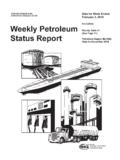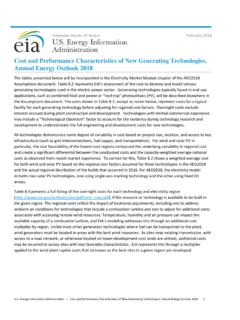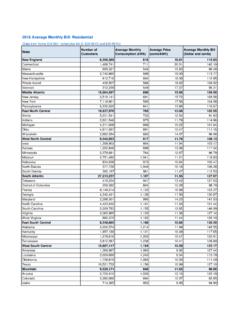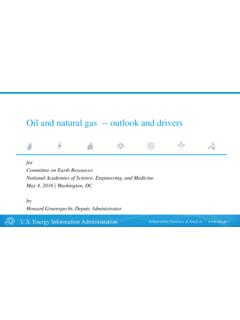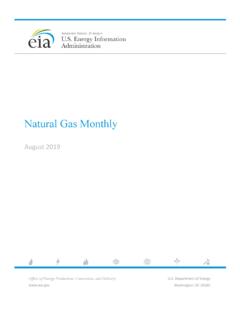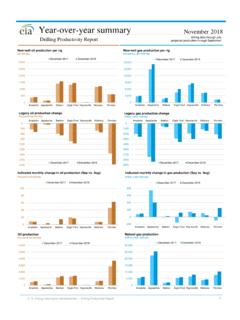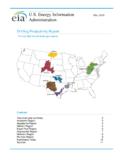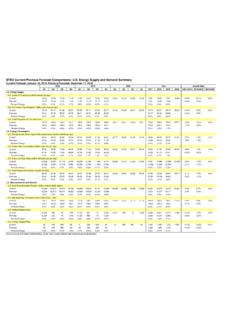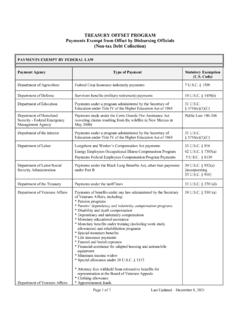Transcription of Short-Term Energy Outlook - Energy Information …
1 November 2018. Short-Term Energy Outlook (STEO). Forecast highlights Global liquid fuels Brent crude oil spot prices averaged $81 per barrel (b) in October, up $2/b from September. Despite the increase in monthly average prices, Brent spot prices declined from $85/b on October 1 to $75/b on October 31. EIA expects Brent spot prices will average $72 in 2019 and that West Texas Intermediate (WTI) crude oil prices will average about $7/b lower than Brent prices next year. NYMEX. WTI futures and options contract values for February 2019 delivery that traded during the five-day period ending November 1, 2018, suggest a range of $53/b to $83/b encompasses the market expectation for February WTI prices at the 95% confidence level. EIA estimates that crude oil production averaged million barrels per day (b/d). in October, down slightly from September levels because of hurricane-related outages in the Gulf of Mexico.
2 EIA expects that crude oil production will average million b/d in 2018, up from million b/d in 2017, and will average million b/d in 2019. regular gasoline retail prices averaged $ per gallon (gal) in October, an increase of 2 cents/gal from the average in September, marking the sixth consecutive month that prices averaged between $ and $ EIA forecasts the average regular gasoline retail price will fall to $ in December 2018. EIA forecasts that regular gasoline retail prices will average $ in 2018 and in 2019. EIA forecasts total global liquid fuels inventories will remain flat in 2018, followed by an increase of million b/d in 2019. Natural gas EIA estimates dry natural gas production in the United States averaged billion cubic feet per day (Bcf/d) in October, up Bcf/d from September. EIA forecasts that dry natural gas production will average Bcf/d in 2018, up Bcf/d from 2017.
3 Both the level and growth of natural gas production in 2018 would establish new records. EIA. expects natural gas production will continue to rise in 2019 to an average of Bcf/d. Energy Information Administration | Short-Term Energy Outlook November 2018 1. EIA estimates that natural gas storage inventories were trillion cubic feet (Tcf) at the end of October. This level was 16% lower than both the 2017 end-of-October level and the five-year (2013 17) average for the end of October and was the lowest end-of- October level since 2005. Despite low storage levels, EIA expects strong growth in natural gas production to put downward pressure on prices in 2019. EIA expects Henry Hub natural gas spot prices to average $ British thermal units (MMBtu) in 2019, down 4 cents from the 2018 average and down from a forecast average price of $ in the fourth quarter of 2018. NYMEX futures and options contract values for February 2019 delivery traded during the five-day period ending November 1, 2018, suggest a range of $ to $ encompasses the market expectation for February Henry Hub natural gas prices at the 95% confidence level.
4 Electricity, coal, renewables, and emissions EIA expects the share of total utility-scale electricity generation from natural gas- fired power plants to rise from 32% in 2017 to 35% in 2018 and to 36% in 2019. EIA. forecasts that the electricity generation share from coal will average 28% in 2018 and 26% in 2019, down from 30% in 2017. The nuclear share of generation was 20% in 2017. and EIA forecasts that it will average about 19% in 2018 and in 2019. Wind, solar, and other nonhydropower renewables provided slightly less than 10% of electricity generation in 2017. EIA expects them to provide more than 10% in 2018, and nearly 11%. in 2019. The generation share of hydropower was 7% in 2017, and EIA forecasts that it will be about the same in 2018 and in 2019. EIA expects total solar generation will rise from 212,000 Megawatt hours per day (MWh/d) in 2017 to 268,000 MWh/d in 2018 (an increase of 27%) and to 303,000.
5 MWh/d in 2019 (an increase of 13%). In recent years, the industry has seen a shift from fixed-tilt solar PV systems to tracking systems. Although tracking systems are more expensive than fixed-tilt systems, revenue from the additional electricity generated by following the path of the sun across the sky often exceeds the increased cost. coal exports for the first eight months of 2018 totaled 78 million short tons (MMst), compared with 60 MMst exported during the same period in 2017. EIA expects coal exports to total 110 MMst in 2018 and 100 MMst in 2019, and EIA expects coal production will total 756 MMst in 2018 (down 2% from 2017) and 729 MMst in 2019. (down 4% from 2018). After declining by in 2017, EIA forecasts that Energy -related carbon dioxide (CO2) emissions will rise by in 2018. This increase largely reflects higher natural gas consumption in 2018 because of a colder winter and a warmer summer than in 2017.
6 EIA expects emissions to decline by in 2019 because temperatures are forecast to return to normal. Energy -related CO2 emissions are sensitive to changes in weather, economic growth, Energy prices, and fuel mix. Energy Information Administration | Short-Term Energy Outlook November 2018 2. Petroleum and natural gas markets review Crude oil Prices: The front-month futures price for Brent crude oil settled at $ per barrel (b) on November 1, a decrease of $ from October 1. The front-month futures price for West Texas Intermediate (WTI) crude oil for delivery at Cushing, Oklahoma, decreased by $ during the same period, settling at $ on November 1 (Figure 1). Crude oil prices declined from the end of September to the end of October at a faster percentage rate than in any month since July 2016. Prices approached four-year highs in early October given the uncertainty about the amount of Iranian crude oil supply coming off the market and whether or not other producers could make up for the shortfall.
7 However, increased indications of a global economic slowdown, as well as higher than expected global petroleum supply, contributed to rapid price declines later in the month. Similar to early 2018, financial markets exhibited significant price volatility in October, contributing to selloffs in risk assets such as equities and commodities. Chinese economic growth was lower than expectations, and leading economic indicators for several countries have slowed, leading to market concerns over the pace of oil demand growth in the coming months. Continued depreciation in emerging market countries' currencies which makes the cost of crude oil imports more expensive have also put downward pressure on the petroleum demand Outlook . EIA is forecasting global petroleum and other liquid fuels consumption growth to average million barrels per day (b/d) in 2019, which is million b/d lower than forecast in the October STEO.
8 In addition to lower expectations for oil demand, higher oil supply estimates for October led to a large increase in global oil inventories. crude oil production increased at a faster rate than EIA previously anticipated. Crude oil production reached a new monthly record of million Energy Information Administration | Short-Term Energy Outlook November 2018 3. b/d in August 2018, according to EIA's latest Petroleum Supply Monthly, which was million b/d higher than EIA expected in the October STEO. EIA now estimates that October crude oil production averaged million b/d, compared with a forecast of million b/d in the previous STEO. Crude oil production in Saudi Arabia and Russia reached some of the highest levels in history last month, helping to offset the months of supply losses from Iran and Venezuela. Venezuela's crude oil production declines have slowed, and estimates of its crude oil exports have increased as its domestic refining system is operating at low utilization rates.
9 Libyan production has resumed at a faster than expected rate because of improved security, and Libya has produced more than 1 million b/d for two consecutive months. These supply developments have occurred when global refinery maintenance is typically at its highest for the year, contributing to an estimated global petroleum inventory build of million b/d in October. The loosening global petroleum balance is also evident in both the Brent and WTI futures curves (Figure 2). The Brent and WTI 1st 13th futures price spread declined $ and $ , since October 1, respectively, settling at $ and -18 cents/b on November 1, respectively. Refinery utilization in the United States in October averaged 89% and commercial crude oil inventories increased by 22 million barrels from the end of September, the largest monthly increase since January 2017. The WTI futures curve is now exhibiting slight contango (when near-term futures prices are lower than longer-dated ones), and the entire curve has flattened considerably in recent months.
10 The rapid flattening of the futures curve reflects the recent petroleum oversupply and lower demand. Even though total refinery utilization was about average for this time of year, it was particularly low in the Midwest, Petroleum Administration for Defense District (PADD) 2. Four- week average refinery utilization for the week ending October 26 was 73%, which, if confirmed in EIA's monthly data, would be the lowest utilization rate in the region for any month in EIA. data back to 1985. Several large refineries planned month-long maintenance, which lowered the demand for and the prices of major crude oils that are typically processed in these refineries, Energy Information Administration | Short-Term Energy Outlook November 2018 4. including Western Canada Select (WCS) and Bakken. In October, the WCS Brent spread traded at the lowest level since 2012, settling at -$ on November 1, and the Bakken Brent spread hit its lowest level since 2013, settling at -$ on November 1 (Figure 3).
